Special foods that can’t be tasted in restaurants and convenience stores, and generosity that cannot be felt amongst the busy city life. Between dense buildings, local markets are a virtual ‘Oasis’. The Dankook Herald (DKH) wants to introduce you to markets around the country that you will not regret visiting.
DKH took subway to Yeongdeungpo Market station. From exit 1, we walked to the Seoul Youth Work Experience Center a ‘Do-it-Yourself Center’ to see the ‘Night Market’ held every last Friday of the month out front. Recycling workshops and flea markets were crowded with people all enjoying the atmosphere.
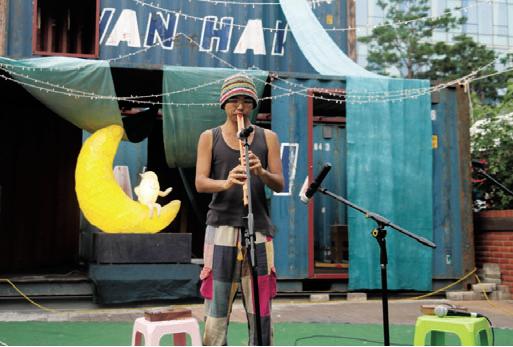 |
| ▲ Music performance at the Moon market. |
In ‘The Workmanship Alley’, there were artists selling handicrafts and teaching people how to make their own. The ‘art market’, had three female students in uniform who caught our eyes. They were grade 8 students, selling bracelets they made at a reasonable price. It was impressive that they are making profits by doing what they enjoy. The marketplace is composed of Workmanship, Share, Experience, and Food Alleys, and each one had something very interesting to offer. We hope you get a chance to explore the Night Market from end to end.
Next, DKH visited Daejeon Central Market. This market located Won-dong, Jung-gu, Daejeon was first established in January 1905 when the Gyeongbu line opened in Daejeon, and now it is one of the biggest traditional markets covering
over 110,000. This markets sells 20 different kinds of wholesale and retail items
including clothes, hanboks (Korean traditional clothes), miscellaneous goods, and plays host to many restaurants. Since the number of visitors is more than 50,000 people a year, you not only look at goods, but also crowds of people.
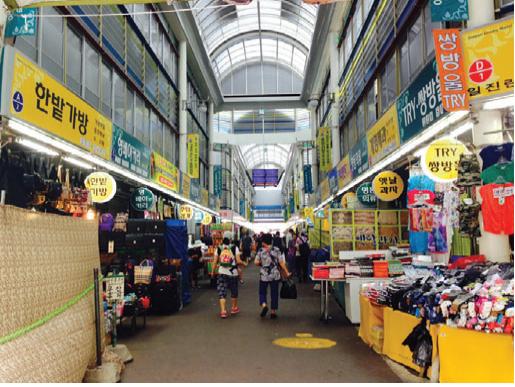 |
| ▲ Daejeon Central Market is modernizing its facilities. |
When you pass the Daejeon River to enter the market, you will notice it is really convenient to park because there is a public parking lot. The current arcade roof, pleasant toilets, and remodeled market buildings are different from the past. As a result, the location and facilities are ideal. They offer inexpensive prices for consumers in a modernized market facility pleasing both merchants and their customers. It is no exaggeration to say that the charm of the Central Market is seeing its beautiful colors.
Since it was Chuseok, Korea’s Thanksgiving, when DKH visited the market, hanbok street came alive more than usual. Many merchants were urging people to try their hanboks, and there were many willing buyers. There were also many stores that sell blankets and bedding welcoming in customers with colorful pillows and blankets.
You can’t say that you have visited a traditional market without eating market foods. There are many restaurants including street vendors that sells noodles, and other diners inside the market, as well as grocery stores along the food alley. Best of all, it is easy to satisfy your hunger at an inexpensive price. The Deajeon
Central Market is famous for its ox blood soup restaurant where it has been only 1000 won for a bowl for more than 20 years. It is also famous for the restaurant called Seoul Chicken where customers get freshly fried chicken on demand, nothing is pre-cooked. These restaurants always have a mass of customers some of which return to relive old memories or others who heard about the restaurants and came from other cities for the first time.
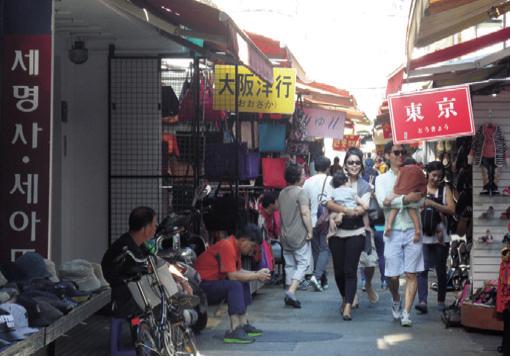 |
| ▲ The middle of Gukje Market. |
The next market we visited was in Busan and is famous for the sea, seafood, and dialect and is also a major tourist attraction. Gukje and Jagalchi Markets are located in Busan, Nampodong. Gukje Market has some relevance in the history of Korean independence in 1945. The Japanese originally formed the market to make money by selling goods during the war before their withdrawal from Korea. After independence, Koreans took over the site, and it is the current location of the Gukje Market. The market blossomed after refugees returned and set up stands on the site to make a living. The market is conventional and doesn’t have a modern urban feel to it.
When you first enter the market you will be surprised at the number of shops on the mazelike roads and signs written in foreign languages like Japanese, English, and Chinese. You also see foreigners regularly. DKH interviewed Olivia who came from the USA and visited Gukje Market. “This market is a wonderful
place. There are so many shops. I think I can buy everything I want like clothes, K-POP CDs, and kitchen utensils, etc. Although it’s too large to look around everywhere, I saw many things, and I’m very glad to have had this good memory of Korea,” Olivia said.
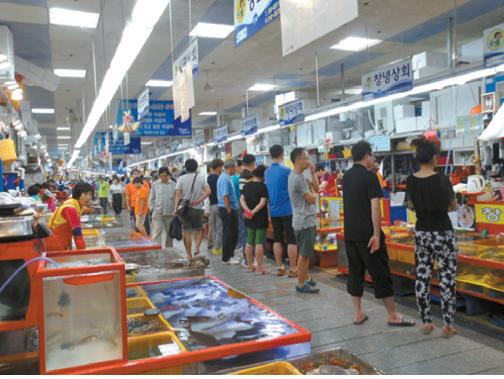 |
| ▲ Stores and merchants of Jagalchi Market. |
DKH also visited Jagalchi Market located close to Gukeje Market. It also shares a similar history and background. However at this market, the first thing you see are the various seafoods for sale. You can buy fish, dried fish, seaweed etc and look around or buy them. Moreover, it is possible to look out at the sea and smell its fresh air while you frequent the market.
There is another more modernized Jagalchi Market right next to the older one. This second Jagalchi Market is a seven-floor building designed in the shape of a gull. The building houses a market for marine products, a raw fish center, a seafood buffet, and a gallery that explores the history and significance of the Jagalchi Market. Moreover from the top of the building, you can view the entire market from above.
These sites are usually vibrant markets, but we could see the crowds were larger than usual because of the special Thanksgiving holiday called ‘Chuseok.’ The market in Pohang plays host to a busy holiday morning. DKU looked around this site too.
DKH visited the Pohang Jukdo Market at six in the morning. Jukdo Market is well known for its fish section attached to a dock for fast and fresh distribution. The first place visited was also the fish market, and despite the early hour, it was crowded with many people.
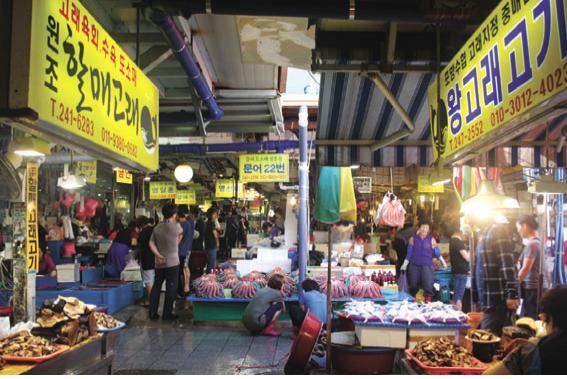 |
| ▲ Have you ever prepared octopus for memorial service? |
We heard a loud bell in the middle of the crowded fish market to signal the start of the fish auction. Among the strange tension between competitive buyers, was the fast flowing hand movements of the buyers and sellers. And by putting up a piece of paper, buyer number 23 wins and the short auction ends. When new fish arrives, the bell is rung again announcing the start of the latest auction. The fisheries auctioneer and the wholesaler wearing a hat and holding a numbered ticket, once again makes deals using wild hand signals. It was a special experience to see the bidding competition though it was very short.
What kind of food do you prepare for a memorial service table? Have you ever prepared octopus for a memorial service? Historically An Dong was the only local place where people prepared octopus. Over time, the use of the octopus in Gyeong Sang increased. Coastal people in Gyeongsang-do prepare several kinds of fish and shellfish, such as whiting, plaice, yellowtail, snapper, as well as octopus.
To attract the attention of consumers, merchants lift up huge octopuses and lay them stretched out on the floor. I recommend a visit to the Jukdo Market if you want to see a variety of seafood and a very special fish market.
With this, we visited representative traditional markets in major cities. Shopping at the hyper markets and buying discount goods are fine, but for special memories, take the time to look around any of Koreas traditional markets which are full of hearty energy. If you feel quite exhausted from the city’s hardhearted people,
go to a traditional market and enjoy a bowl of their nice, hot noodles.
한가을, 서민지, 박정운, 이지선 dkherald@hotmail.com

![[Campus Magnifier] Let's Surf the Library!](/news/photo/202404/12496_1765_4143.jpg) [Campus Magnifier] Let's Surf the Library!
[Campus Magnifier] Let's Surf the Library!
![[Campus Magnifier] Let's Surf the Library!](/news/thumbnail/202404/12496_1765_4143_v150.jpg)





